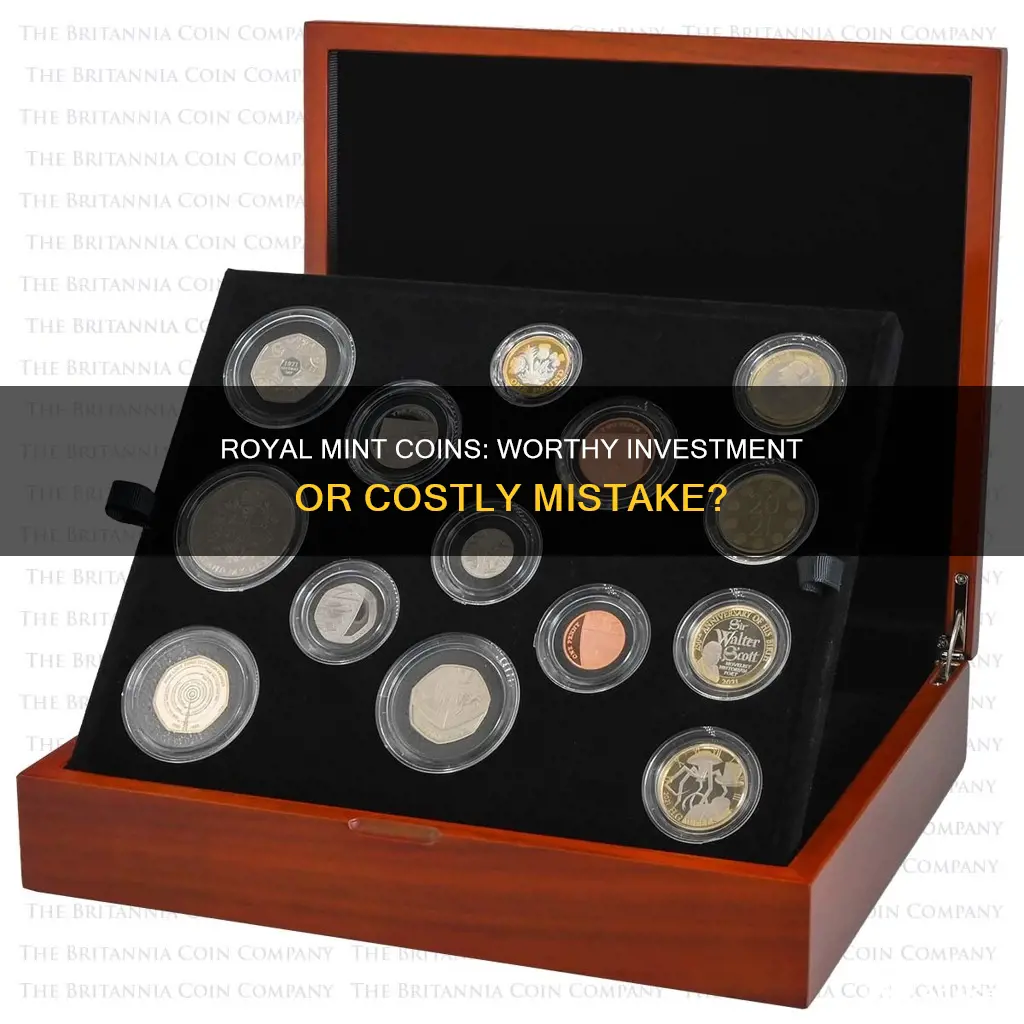
The Royal Mint has been minting coins in the UK for over 1,100 years and is the world's most technically advanced minting facility. It produces almost all of the UK's coins, as well as coins for over 60 other countries. The Mint's coins are often sought after by collectors, with some rare coins increasing in value over time. For example, a 1973 EEC 50 pence coin is now valued at £3,000. Gold is generally considered a reliable hedge against inflation, and its value tends to rise during economic uncertainty. However, it is important to note that modern commemorative coins are usually not good investments, as they are not expected to increase in value and are rarely accepted by shops or banks.
What You'll Learn

The Royal Mint's history and role in the UK
The Royal Mint is the United Kingdom's official maker of British coins. It is currently located in Llantrisant, Wales, where it moved in 1968. The Royal Mint has been minting coins in the UK for over 1,100 years and is the most technically advanced minting facility in the world.
The Royal Mint largely grew out of the London Mint, which was located within the Tower of London for several hundred years. In the 13th century, the London Mint was the most powerful mint in the country, and it was this mint that would go on to become the Royal Mint. In Medieval times, the monarchy needed a way of ensuring that gold coins were worth exactly what people said they were. At the time, different people and parts of the British Isles could mint their own coins, meaning that not all coins were produced using the same standards or measurements.
In the early 16th century, England was suffering from financial difficulties brought on by excessive government spending. By the 1540s, wars with France and Scotland led Henry VIII to enact The Great Debasement, which saw the amount of precious metal in coins significantly reduced. In order to strengthen control of the country's currency, monasteries were dissolved, which effectively ended major coin production outside London.
In 1805, construction began on a new purpose-built mint on Tower Hill, opposite the Tower of London, and it was completed by 1809. By 1856, the mint was beginning to prove inefficient, with irregularities in the fineness and weight of minted coins. German chemist August Wilhelm von Hofmann was consulted, and he recommended his student George Frederick Ansell to resolve the mint's issues. Ansell discovered that the weighing of metals at the mint was extremely loose, and he implemented more precise weighing equipment to increase the accuracy of weights.
In the 1960s, the British government decided to move some government departments out of London and into regions that needed extra development. This led to the decision to move the Royal Mint to Llantrisant, Wales, where it remains today.
The Royal Mint is a leading provider of precious metal products and has expanded into precious metals investment, historic coins, and luxury collectibles. It produces all of the country's physical currency apart from banknotes, which are printed by the Bank of England. The mint also regularly produces commemorative coins for the collector's market, with a range of varying quality and made of different precious metals.
Investing in Bitcoin: Risky Business or Safe Bet?
You may want to see also

The value of commemorative coins
Commemorative coins have been around since the days of the Greeks and Romans, used to record and honour important events and pass on news. In the present day, they are issued to celebrate national events of significant importance, such as royal occasions, or to help pay for monuments and celebrations commemorating historical persons, places or things.
The Royal Mint produces commemorative coins to celebrate royal birthdays and jubilees. These coins are considered souvenirs and are rarely found in everyday circulation. They are classed as legal tender but are not accepted by banks, shops or businesses for cash transactions. Commemorative coins are, however, accepted for payment of debts in court.
Collectors of commemorative coins tend to be more interested in the historical side of coin collecting. Commemorative coins can be an attractive item to display and can deliver a degree of personal satisfaction. However, from an investment point of view, they are not always a great choice. Commemorative coins can appreciate in value, but this is not always the case. They can often be bought on the secondary market for less than their original sale price.
Genuine numismatic coins have a higher chance of increasing in value. These are typically made from gold or silver and have an intrinsic value as a precious metal. Numismatic coins are also worth more if they are scarce or had a low mintage rate.
The Atari Coin: A Worthy Investment?
You may want to see also

The benefits of investing in gold
Gold has been valued and treasured for thousands of years, and its value lies in the metal itself rather than the promise to pay, as with banknotes. Here are some benefits of investing in gold:
Gold is a store of value
Gold has successfully preserved wealth throughout thousands of generations. For example, in the early 1970s, one ounce of gold was equal to $35. If you had held on to that ounce of gold and sold it today, it would be worth a lot more than $35. However, if you had kept $35 in cash, its value would have been eroded by inflation.
Gold is a hedge against inflation
Gold tends to increase in value when other investments decline, providing stability for your portfolio. With rising inflation, gold typically appreciates in value, and investors will often turn to gold to protect their wealth.
Gold is a safe-haven asset
Gold is often described as a 'safe-haven' investment in times of market volatility. During times of economic uncertainty, investors often buy gold to protect their wealth.
Gold is a global currency
Gold has value anywhere in the world and can be exchanged between people from different countries and societies with minimal formality and no foreign currency costs or transaction fees.
Gold is highly transferable
Gold, especially in the form of bullion coins, is portable and can be moved from one person to another with minimal fuss.
Gold is a transparent investment
The pricing of gold is transparent, with prices published daily in newspapers and on websites. Gold can be sold back into the market with confidence, and there is a competitive market for both the sale and purchase of gold.
Gold is a diverse investment
Gold is not correlated to stocks, bonds, or real estate, so it can be a place of relative safety when other investments are declining.
The Ultimate Guide to Investing in Bitcoin Stock
You may want to see also

The secondary gold market
Gold on the secondary market is often cheaper than buying new gold, due to wear and tear on the packaging or the product itself. However, the fine gold content remains the same, regardless of the condition of the product. This presents an opportunity for investors to buy gold at a lower price point, and for collectors to find old and rare gold coins.
The secondary market also has some disadvantages. For collectors seeking perfection, the secondary market may not be the best option, as older and rarer coins are unlikely to be in pristine condition. The secondary market also leaves buyers open to scams and dishonest traders. It is important to only buy from reputable sellers with positive reviews and open feedback.
Some mints have introduced special packaging to help buyers identify whether gold bullion products are genuine, even after they have been sold into the secondary market. Using a trusted and well-rated gold bullion distributor with a secure and verified payment system is a safer alternative to live auction or second-hand sites.
Overall, the secondary gold market provides more opportunities and flexibility for investors and collectors, particularly those looking for cheaper gold bullion or rare coins.
Coinbase Investment Opportunities: Exploring Your Options
You may want to see also

Numismatics
The Royal Mint, a UK-based mint with over 1100 years of history, presents an opportunity for numismatists to invest in coins with potential future value. The Mint regularly releases new coins, many of which are approved for limited circulation, making them potentially lucrative collectibles. For example, the 1973 EEC 50 pence coin, originally released by the Royal Mint, is now valued at £3,000.
Beyond their face value, coins from the Royal Mint can appreciate over time due to their historical value and limited supply. The older a coin is, the more valuable it tends to become. Additionally, the Mint offers coins made from precious metals like gold and silver, which can be a safe, long-yielding investment. These metals retain essential properties of money, such as price fluctuation and limited supply, making them attractive assets.
For those interested in numismatics, the Royal Mint provides an opportunity to invest in coins that may increase in value over time. The Mint's long history, combined with the limited availability of certain coins, contributes to their potential as a collectible investment. However, as with any investment, it is important to conduct thorough research and due diligence before making any decisions.
How to Invest in Bitcoin Without Actually Buying It
You may want to see also







